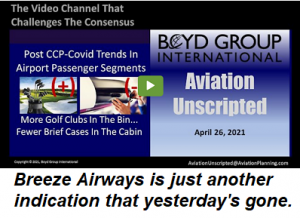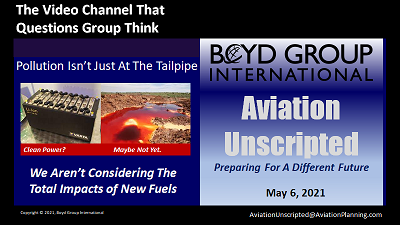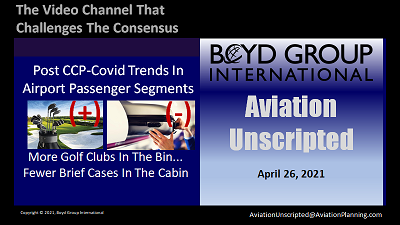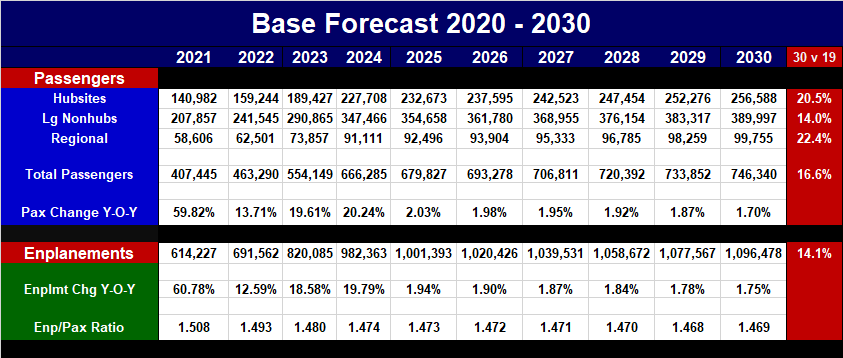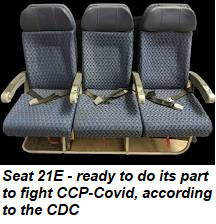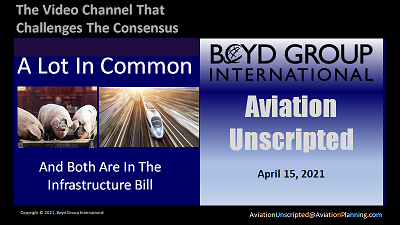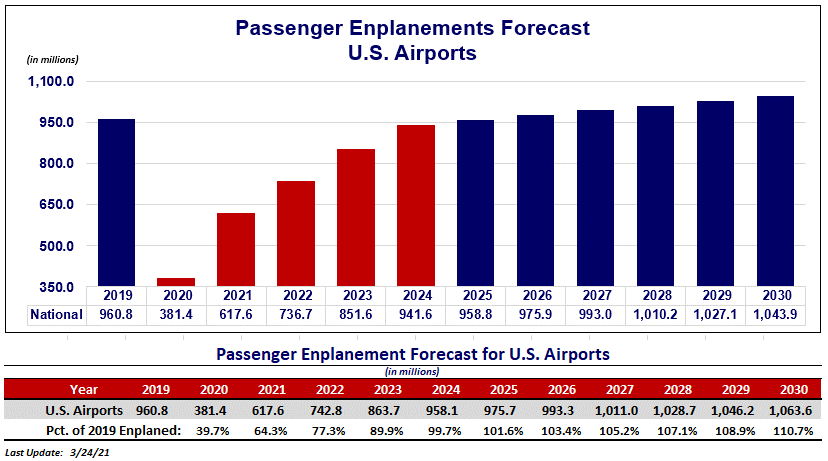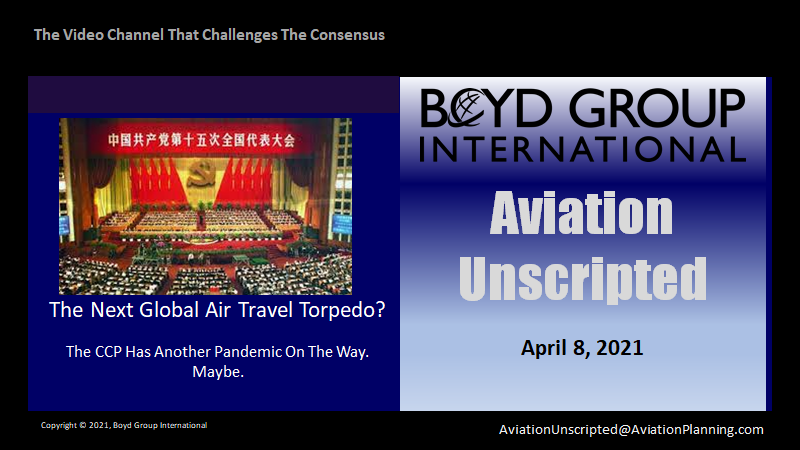Supersonic Realities –
Confusing Mach With The Clock
R.I.P. – Aerion, a company once allied with Boeing to build a supersonic business jet, has gone 86. Out of capital.
Lots of fanfare surrounded this project. It’s failure now logically brings to the forum the question whether it’s economically possible to produce supersonic flying machines.
The answer is a definite “yes.” And a definite “no.”
Reason: whether an airplane can create a sonic boom is a complete non sequitur. Speed, per se, isn’t the basic criterion. Time is.
To Start: Concorde Is Not A Part of The Discussion. Since the demise of the Concorde (or just “of Concorde,” as they say in the Mother Country) there have been any number of proposed platforms intended to be supersonic airliners, or in the case of Aerion, 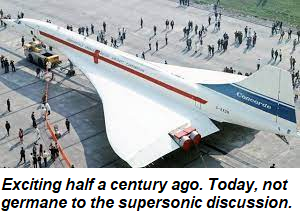 supersonic business jets.
supersonic business jets.
First, we need to forget the Concorde – it rolled out of the hanger 54 years ago, when a color TV was a prestige item, an IBM Selectric was an office staple, and ads for Virginia Slims told us they were latest things to suck on to abuse our lungs.
Concorde represents ancient technology produced long ago in an aviation galaxy far, far away. We need to talk about the concept of supersonic air transportation in the future environment.
The Only Criteria: Clock Time, Not Travel Time. Anybody want to opine on why there supposedly is a market for machines that can burn a Mach hole in the sky? The typical answer is “to get there faster.”
Hit the buzzer. Wrong answer.
The only absolute criteria – for a supersonic anything is to improve time-efficiency. That’s total time-efficiency, not just whether the plane flies faster. That means the time gained by popping past Mach 1 has to be material, valuable, and useable. What a lot of folks miss – ignore, actually – is that humans – and businesses – operate according to what time it is, like day or night.
Let’s look at this.
In 1989, Boyd Group International was engaged by an aircraft manufacturer to study the feasibility of an envisioned 150-seat, all business class supersonic airliner with the design route criteria being San Francisco – Shanghai, 6,151 miles, nonstop.
The research found that all the parts and factors were already available. The powerplants – military grade – already existed. The design and materials for the proposed airliner were on the shelf, and not out of reach.
The research indicated that the envisioned platform was entirely technically possible, although price per unit would send any airline CEO to guzzle down the nearest bottle of Pepto-Bismol.
The real cost issue we discovered was that the airliner absolutely had to be capable of close to 2.0 Mach or higher. That meant the need to burn a lot more go-juice, a.k.a., jet-A. Any less and the thing would fail to meet the foundational criteria: saving time. No functional working time is saved if the airplane had to depart in the middle of the night or arrive at 3AM. It’s that day and night thing that humans operate in. Mach 2 and above had to be the capability.
The Aerion project – an 8-12 seat business jet at 1.4 Mach – had just this problem to face over the Atlantic. It wasn’t fast enough to provide the occupants with more usable time at both ends of the flight. That’s aside from the plane’s price being just short of the annual budget of a small Midwest city. Time is money… but maybe not that much money. Over $120 million per copy, and the only commercial application was executive travel. Not a big sector to start with. Flexjet ordered 20, but the phones at Aerion didn’t overheat with a lot more orders.
Point: the need for speed is not the issue. It’s the need for increased time-efficiency. The 2.0 Mach Concorde delivered it, although in just about every other aspect, the airplane earned itself a chapter in a book called “Great Planning Disasters.” (True.) Ego, hubris, and political arrogance were the main drivers of the Concorde project. And the taxpayers in France and England got the bill.
But Supersonic Is Still Coming. What’s left in the stable of future supersonic planning is the Overture – a 75-85 seat airliner being developed by Boom Technologies of Denver. The key issue here is that the airplane was not envisioned to be a supersonic machine, per se, as an objective. That capability was necessary to accomplish the design criteria… to increase passengers’ time-efficiency. Hence a near 2.0 Mach planned cruise speed. In addition, all of the technology is already in place – there is innovation, but Buck Rogers is not on the team.
A Market Value. A Market Need. But In A Changing Air Transportation System. As with any major project, cost of 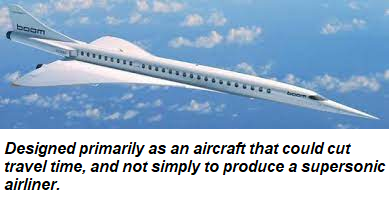 development and market cost of the Overture will affect ultimate demand. BGI’s original forecast for Boom in 2016 was for over 3,000 units over a ten-year period, based on the assumptions provided regarding operational costs on both segment and per-seat criteria.
development and market cost of the Overture will affect ultimate demand. BGI’s original forecast for Boom in 2016 was for over 3,000 units over a ten-year period, based on the assumptions provided regarding operational costs on both segment and per-seat criteria.
To be clear, there have been material changes in all aspects of the international travel market, and we have not done an update. However, we believe that, as currently postured, the Overture has a strong operational role. It is a fact that leisure international traffic has declined, as has business-related demand.
However, BGI global forecasts indicate that, contrary to the U.S. domestic marketplace, the return of leisure travelers in international markets will be a lot slower than business-generated demand.
Trans-Atlantic and trans-Pacific business travel will be there. Leisure international traffic will be sluggish for the same reason that domestic leisure was until recently a giant blob of deferred demand: nobody can predict what local authorities may do as they chase their tails trying do address the CCP-Covid situation. Taking the family to see the Colosseum could result in some nasty surprises. China-U.S. leisure travel – as we’ve alone pointed out – is dead. Business travel – especially such that increases productive time – is less vulnerable.
Take it to the bank – supersonic travel is still on the horizon.
_________________
Announcing!
A New Sponsor, and Vox Deorum Join Us At Aviation Unscripted
Some important changes happening at our video channel, Aviation Unscripted.
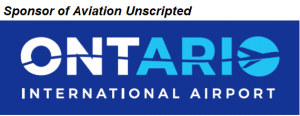 First, we’re honored to announce Ontario International Airport as an official sponsor of the channel. ONT has been at the forefront of taking aggressive new directions as a result of the effects of the CCP-Covid pandemic.
First, we’re honored to announce Ontario International Airport as an official sponsor of the channel. ONT has been at the forefront of taking aggressive new directions as a result of the effects of the CCP-Covid pandemic.
This ties in well with our approach at Aviation Unscripted, which is to question ambient thinking and the understanding that “being up to date” simply means being behind the future. No airport, business or individual can achieve excellence by running with the pack.
Second, we’re introducing a new feature to Aviation Unscripted. From time to time, we will be reaching out to innovative aviation leaders, to discuss how they are addressing the evolution of the industry. No, not panel exploration of what to do, but they will be telling us how they are dealing with key issues.
Very tongue-in-cheek, we’re calling it Vox Deorum – voice of the gods. We think there is a place for a medium where these voices can pass on their wisdom and experiences.
The first Vox Deorum video at Aviation Unscripted is now on-line.
 We thought it might be appropriate to hear from our first sponsor, Ontario International Airport. So we asked Mark Thorpe, CEO to tell us how he views changes and opportunities in the post-pandemic environments.
We thought it might be appropriate to hear from our first sponsor, Ontario International Airport. So we asked Mark Thorpe, CEO to tell us how he views changes and opportunities in the post-pandemic environments.
Log on… Mark brings up some interesting concepts that are pertinent and thought-provoking to airports elsewhere in the nation. What’s happening in the Los Angeles Basin may be the template for other multi-airport regions, such as increased balkanization of traffic between airports, more need for focus on airport costs (the Frontier deletion of LAX flights being one example) and more.
Part Two of the Vox Deorum with Mark will be on-line this Thursday, June 3, at Aviation Unscripted. Get prepared. We’ll be talking about new approaches airports can take to reduce costs, while increasing marketing flexibility. Plan on just a touch of heresy from traditional thinking.
A Growing Channel of Perspectives. We want to thank the folks who are accessing Aviation Unscripted, both directly at Rumble.com and other access channels. As we’ve mentioned in the past, we have pulled our videos from the former channel at Youtube. We have left one video that bluntly explains the reasons. We prefer truth.
Click here to log on to the channel – feel free to explore. You’ll note that we aren’t reticent to barbecue sacred cow beliefs. While there, we’d be appreciative if you hit the subscribe button, too!
__________________
